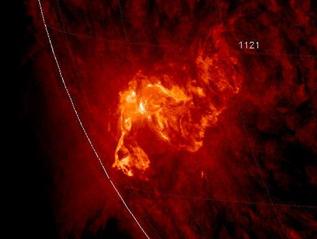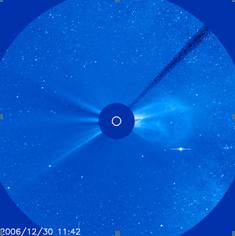 (NASA) |
 (NASA/ESA) |
Although solar flares have been observed since 1859, solar coronal mass ejections have only been observed since around 1970. During that time there has been much discussion about possible associations between these two energetic solar phenomena. It has been observed that the association between flares and CMEs appears very poor at the low end of the energy spectrum ,rising to a tight coupling at the highest energies.
Until the launch of the Solar Dynamics Observatory (SDO) satellite on 11 February 2010, the generally quoted statistics of flare-CME correlations were given by the table below:
| Flare X-ray class | CMEs accompanying flare | |
|---|---|---|
| C | 20% | |
| M | 40% | |
| X | 100% |
However, recent results from SDO now indicate that 80% of all detected C-class flares also show a coronal mass ejection. The solar production of X-ray flares in cycle 24 has so far been too low to allow any significant conclusion to be drawn for higher energy flares.
As with most data, there is more than one possible explanation. Are SDO sensors more sensitive than those on previous spacecraft so that they detect more CMEs? Or is the behaviour of cycle 24 different from that of its predecessors? It has been suggested that the lower solar magnetic fields in this cycle may allow more CMEs to escape (or be accelerated) from the lower solar altitudes.
 (NASA) |
 (NASA/ESA) |
 Australian Space Academy
Australian Space Academy